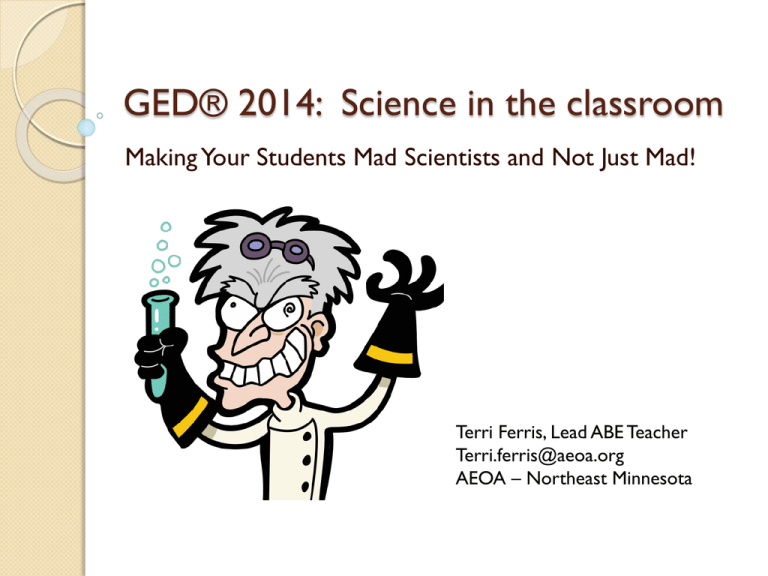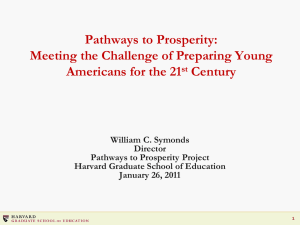Science In Your Classroom - Minnesota Literacy Action Network
advertisement

GED® 2014: Science in the classroom Making Your Students Mad Scientists and Not Just Mad! Terri Ferris, Lead ABE Teacher Terri.ferris@aeoa.org AEOA – Northeast Minnesota Two of My Classrooms •Completed every science class my HS had to offer. •Studied nursing my 1st year of college •Changed my major to teaching (special education) •Employed by AEOA for 20 years •Have taught in a ABE for 14 years •Teach 3 classes (2 one-room school house, 1 college prep) •Also have worked as a vocational evaluator and an employment counselor About Terri Ferris What do you know about Terri? 1. What are my favorite sports teams? 2. What kind/how many pets do I have? 3. What is one of my favorite places? 4. What kind of technology is in my classroom? 5. What color is one of my classrooms? Goals for Today: Demystify some of the GED 2014 Science Practices Examine some of the GED 2014 Science Content Generate ideas for how to adapt current materials to match GED 2014 test items Develop teaching strategies to use in your classroom Gain Resource ideas Have some fun! Comparing our Students’ and Scientist’ Approach to Science Scientists Perception of Purpose Hope to contribute new knowledge through inquiry Planning Process Debate, argue and challenge explanations and evidence Draw from work of their peers Extensively plan before beginning Our Students Perception of Purpose Hope to complete a task Planning Process Struggle to make sense of what is being asked of them Have trouble making a hypothesis Generally prefer to “get on with it” rather than plan Comparisons Continued Scientists Actions Taken Based on what will maximize their chances of finding answers Making Meaning Debate even ‘straightforward” evidence Making Meaning Ignore anomalous data and make changes/adjustments to the experiment Our Students Actions Taken Based on what their teacher tells them to do Making Meaning Assume that the correct meaning of data will be evident based on experiment results Making Meaning Associate anomalous data with mistakes Instructional Shifts for 2014 Science A greater need to teach higher order thinking and problem solving skills ◦ Levels 1, 2, and 3 of Webb’s Depth of Knowledge will be incorporated into the 2014 test Integrate the content areas ◦ Data analysis will be measured on the science, social studies, and math tests Teach academic vocabulary that crosses content areas ◦ Mean, median, mode, probability (math, science, social studies) Instructional Shifts (cont.) Use content-rich materials and websites to teach concepts ◦ Test takers will need a definitional understanding of the assessment targets ◦ Develop each test takers background knowledge Integrate digital literacy skills ◦ Dragging and dropping, navigating tabs, radio buttons, etc What Is It? Science Practices Basic scientific practices assessed on the 2014 test: •Determining details and making inferences •Determining central ideas, hypotheses, and conclusions •Analyzing events and ideas •Interpreting meaning of symbols and terms •Analyzing structures •Integrating content presented in diverse ways •Evaluation reasoning and evidence •Analyzing relationships between sources •Reading and interpreting graphs, charts, and other data representations •Measuring the center of statistical dataset (Hand-out) •Determining sample space and using probability models to interpret data •Understanding and applying the appropriate tools, techniques and units in scientific investigations (Hand-out) Hand-out and Activity 2014 Science Content PD Survey Areas of Concern Molecular basis of heredity Chemical properties and reactions related to living systems Activity: Bean Genes Hand-out: Molecular Basis of Heredity Hand-out: Identifying Chemical Formulas GED 2014 Science Test MODIFYING CURRENT MATERIALS AND TEACHING STRATEGIES Some Strategies for Teaching Science Virtual Field Trips ◦ http://hubblesite.org Case Studies Role Playing Mysteries Posters Webquests ◦ http://webquest.org Concept maps POE Method (Predict, Observe, Explain) Five Es Method (Engage, Explore, Explain, Elaborate, Evaluate) Strategies Continued Multimedia Presentations Creating Board Games Collaborative Work Problem Based Learning The teacher ◦ Presents a problem or issue The Students: ◦ ◦ ◦ ◦ ◦ ◦ Explore the issue List what they know Develop a problem statement List the possible outcomes/what they need to know Research and experiment Present and defend their conclusions Strategies for Teaching Science Vocabulary Reading Science Text Cards ◦ True/false cards ◦ Agree/Disagree Cards ◦ Matching pairs ◦ Sequencing ◦ Classification Word Lists/Word Banks/Word Wall ◦ Procedure Words (compare, contrast, …) ◦ Opposites ◦ Movement Words (accelerate, float, …) Word Games (Hangman, Pictionary, …) Word Parts [metamorphosis – meta (large), morph (change), osis (process)] Graphic Organizers Multiple Meaning Words (matter, conductor, …) Modify the Question What do different scientists believe, but have not yet proved, to be true about the effects of a reduced-calorie diet? A. The diet can extend the maximum life span only of short-lived animals. B. The diet cannot extend the maximum life span of long-lived animals. C. The diet can extend the maximum life span of all animals. 1) A only 2) B only 3) C only 4) A and B only 5) A, B, and C GED Science (Steck-Vaughn) A. The diet can extend the maximum life span only of short-lived animals. B. The diet cannot extend the maximum life span of long-lived animals. C. The diet can extend the maximum life span of all animals. What do different scientists believe, Move the correct answer(s) into but have not yet proved, to be true the box with the question. about the effects of a reduced-calorie diet? A B C TEACHING STRATEGY: TWENTY-FIVE Write a summary for the following passage The process of digestion begins with your first bite of food. Digestion takes place in your mouth, stomach, and intestines. During digestion, food is broken down into small molecules that pass into the bloodstream. The process of absorption comes next. During absorption, food molecules, now in the blood, pass into cells. In the next process, assimilation, cells use the food molecules as a source of energy and for body growth and maintenance. From: Top 50 Science Skills for GED Success (McGraw Hill) Skill 1: Summarizing the Main Idea The answer the book gives: Food nourishment takes place in three equally important steps Recreate Charts with Other Visuals In our solar system, eight planets orbit the sun. The average distance of a planet’s orbit is measured in astronomical units (AU). One AU is the average distance between Earth and the sun, which is about 93 million miles, or 150 million kilometers. The table below shows the distance of each planet from the sun; its period of rotation on its axis; and its period of revolution around the sun. Planet Distance from sun (AU) Rotation (hours) Revolution (days) Mercury 0.39 1048 88 Venus 0.72 5832 225 Earth 1.00 23.9 365 Mars 1.52 24.6 684 Jupiter 5.20 9.9 4,330 Saturn 9.54 10.6 10,800 Uranus 19.18 17.2 30,700 Neptune 30.06 16.1 60,200 Based on the information in the table, what is the average distance between Mars and the sun? Keys to GED Success Science (Steck-Vaughn) Activity Solar System in Your Pocket TEACHING STRATEGY: WHO’S THE EXPERT Write an example that demonstrates a learned behavior Below are five types of behaviors shown by all vertebrates –animals with backbones. Inborn behaviors Reflex – an automatic response to a stimulus Instinct – a complex, unlearned response that is not dependent on experience Self-preservation – a reaction for the purpose of escaping life-threatening danger Learned behaviors Conditioned response – Learning that connects an unusual stimulus with a desired response Intelligent behavior – a complex response that uses past learning in new situations From: Top 50 Science Skills for GED Success (McGraw Hill) THE QUESTION/ANSWER IN THE BOOK Each time Andy claps his hands, his parakeet sings. What type of behavior is the parakeet showing? conditional response Modify the Question Kingdom Description Monera Single-celled organism (with no separate nucleus) such as bacteria and blue-green algae that perform photosynthesis. Protista Single-celled organism (with a separate nucleus) such as protozoa and multi-celled organisms such as seaweed. Fungi Molds, mildew, mushrooms; Usually multi-celled; plantlike, but do not perform photosynthesis. Plantae Plants; multi-celled; perform photosynthesis. Animalia Animals, including mammals and insects; multi-celled. Lydia works in a lab and examines a slide under a microscope. She sees tiny one-celled organisms without nuclei. The genetic material is floating inside the cells. In which kingdom should this organism be classified? 1) Monera 5) Animalia 2) Protista 3) Fungi 4) Plantae GED Skill Workbook Science (New Readers Press) Kingdom Description Monera Single-celled organism (with no separate nucleus) such as bacteria and blue-green algae that perform photosynthesis. Protista Single-celled organism (with a separate nucleus) such as protozoa and multi-celled organisms such as seaweed. Fungi Molds, mildew, mushrooms; Usually multi-celled; plantlike, but do not perform photosynthesis. Plantae Plants; multi-celled; perform photosynthesis. Animalia Animals, including mammals and insects; multi-celled. Fill-in-the-blank Lydia works in a lab and examines a slide under a microscope. She sees tiny one-celled organisms without nuclei. The genetic material is floating inside the cells. This organism is classified in the kingdom. GED Skill Workbook Science (New Readers Press) TEACHING STRATEGY:VALUE LINE What is the pH of acid rain? The pH scale, from 0 to 14, measures the acidity or alkalinity of a substance. Pure water, with a pH of 7, is neutral. Acids have pH readings below 7; bases have pH readings above 7. The lower the pH, the more acidic the substance. Normal rainwater ranges from 5 to 6.5. Tomato juice has a pH of 4; lemon juice has a pH of 2 Al hypothesized that acid rain (not normal rain) fell in his city. To support his hypothesis, which pH range must his rainwater readings fall into on average? 1-3 3-5 5-7 7-9 9-11 11-14 Pass the GED Science Test (New Reader Press) Evaluate What You Read pages 10-11 THE BOOKS ANSWER Acid rain has a pH below 5 VALUE LINE Additional Examples On a scale of 1-10, 1 being I totally disagree and 10 being I totally agree Where do you stand on: 1. 2. 3. Global warming is actually happening Humans are causing global warming If I drop a penny off the Empire States Building it will make a hole in the sidewalk when it hits Resources (Hand-out) Match Card Science Human Anatomy www.kid-friendly-homeschool-curriculum.com Dsc.discovery.com/videos











